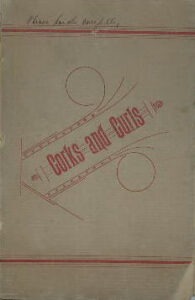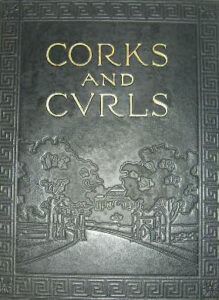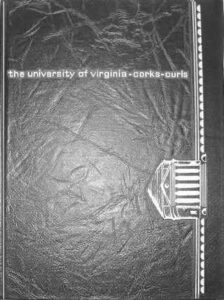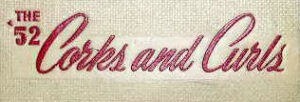116 Years of Corks & Curls
Date:
25 April 2004 – 1 November 2004
Location: Dome Room, UVA Rotunda
Curated by: Whitney Spivey '05
 The University of Virginia was 68 years old in 1887. An all-male institution, the Cavalier men functioned via an intricate network of academic and social organizations, University traditions, and community events. Students were involved with fraternities, athletic teams, literary societies, club sports, even a Temperance Union and a cribbage club. What they did not have, however, was an annual yearbook.
The University of Virginia was 68 years old in 1887. An all-male institution, the Cavalier men functioned via an intricate network of academic and social organizations, University traditions, and community events. Students were involved with fraternities, athletic teams, literary societies, club sports, even a Temperance Union and a cribbage club. What they did not have, however, was an annual yearbook.
This deplorable state of affairs changed a year later in 1888, when J.H.C. Bagby headed the first successful yearbook staff at the University. His staff was composed of one brother from each fraternity. The fourteen editors wrote in the preface of the inaugural yearbook:
“While we hope that it will be considered a success and a credit to the college, we feel strongly that it is not worthy of the leading college in the South, nor of the genius and talent to be found among its students. Be it successful or unsuccessful, let us hope that it will at least be permanent, and serve as a foundation on which to base successful and creditable productions in years to come.”
The Name: UVA student Ernest M. Stires suggested the title Corks & Curls, and a contest was held for the best rationalization of the name. Leander Fogg (of the Medical Class) won. Fogg explained that cork described an unprepared student who was called upon in class but who remained silent, like a corked-up bottle. In contrast, curl referred to a student who performed well in class and who, when patted on his head by his professor, “curleth his tail for delight thereat.” One might cork an examination but put a curl on a quiz.
The editors of Volume I said that they placed Corks in front of Curls for modesty’s sake. “The title thus chosen was a happy one,” they suggested. “Unique, indigenous, esoteric, it is full of meaning for the elect, while at the same time it piques the curiosity of the uninitiated.”
The Early Years: The editors of the first yearbook aimed their publication at a group of a few hundred students and professors whom they knew well—a small and very different audience from the one current editors must face. The original editors could afford to take liberties in their writing, sometimes making comments that those outside their closed community might not understand. The editors obtained a surprising range of personal information about their classmates, presented in a section entitled “Statistics” that listed (among other things) the average height, weight, hair color, religion, bedtime, and expenses of Virginia students, along with superlatives such as “best looking,” and “most studious.”
The 1888 book does not provide individual mugshot photographs or even a list of names of the students enrolled at the University. The first complete catalog of student names and hometowns appears for the first time in 1892 (vol. 4), arranged over four pages. By 1894 (vol. 6), the list expanded to include place of residence while at school. Two years later, the names of fraternities and school years were added.
Sports were widely covered in early editions of Corks & Curls. Pen-and-ink sketches above a listing of athletes’ names denoted each team in early editions; 1911 (vol. 23) marked the first year that the sports section contained colored, illustrated dividers and candid black-and-white photographs. In 1912 (vol. 24), the football team was recognized by photographs of individual players; these men were the only students to have mug shots that year. Mug shots of the entire graduating class appear for the first time in 1933 (vol. 45).
sketches above a listing of athletes’ names denoted each team in early editions; 1911 (vol. 23) marked the first year that the sports section contained colored, illustrated dividers and candid black-and-white photographs. In 1912 (vol. 24), the football team was recognized by photographs of individual players; these men were the only students to have mug shots that year. Mug shots of the entire graduating class appear for the first time in 1933 (vol. 45).
Greeks: Only 365 men were enrolled in the University in 1888. Of these, 192 (more than half the student body) were members of fraternities; and the editors (who printed their fraternity affiliations above their heads in the staff photograph) devoted over half of Volume I to the different fraternal organizations at Virginia. Beginning in 1891 (vol. 3), the title page emphasized that the annual was “published by the fraternities.” Only in 1952 (vol. 63) did the title page of Corks & Curls begin to read: “published by the students of the University of Virginia.” In 1926 (vol. 38), a “Statistical Studies in Scholarship” section compared fraternity’s grades to each other as well as to the rest of the University. Beta Theta Pi ranked first among fraternities with average grades of 84.4% for the ’24-’25 year. Overall, the average fraternity grade for students in the college was 1.7% higher than the average non-fraternity grade (76%).
Minorities: Over the long history of Corks & Curls, the yearbook’s editors have had changing attitudes toward different races, genders, social classes, and events at the University. The 1890 (vol. 2) editors write, “Many odd and picturesque characters of the negro race are to be met with everywhere around the University, but that notion is now fast passing away before the superior intellectual culture and proud assertion of equal rights on the part of their descendants.” Not uncommonly, however, many pages of the early yearbooks contained caricatures of blacks.
In 1962 (vol. 73), Leroy Willis became the first African American to graduate from the University in the College of Arts and Sciences. The following year Dr Martin Luther King, Jr spoke to 900 students at Old Cabell Hall. Neither event was documented in the 1963 (vol. 74) yearbook. Nine years later, Corks & Curls did publish an article on what it meant to be black at the University. The editors wrote: “Having no Black staff members, we were in a quandary as to how we might accurately depict the Black experience here.” One thing we do know well is that unless you are Black, and are at this university, you can never really know what that combination means.”
The preface to the 2003 (vol. 115) yearbook (edited by Jennifer Kalletta) suggests the staff’s current interest in diversity: “We have broadened our areas of academic concentration from philosophy, arts and science, to include African-American Studies, Religious Studies, and Women’s Studies. We learn lessons from each other about acceptance, understanding, and honesty.”
Women: Women undergraduates were not admitted to the University until 1970, though daughters of UVA professors could attend classes as early as the 1920s. One of the most floral of the many elaborate Corks & Curls tributes to women appears in the 1895 (vol. 8) dedication: to “Southern Womanhood: ever the inspiration and support of Southern chivalry with pride in her patriotism, reverence for her purity, love for her matchless tenderness, and trust in her unfading truth.” The 1914 (vol. 26) yearbook opens with a poem dedicated to the “girls we loved, still love, and always will love”:
We loved the cardinal in thy sweet red lips
We loved thee to thy dainty finger tips
Oh girl of Albemarle!
For all thy gentle kindliness,
For all thy loving friendliness,
And all thy dear sweet wholesomeness,
We love thee still!
In 1939 (vol. 51), a poem entitled “Wahoo Week-Ends” tells a grand tale of visiting girls from different schools, including Richmond debs and made-to-order Southern belles from Sweetbriar. A year after women undergraduates appeared around Grounds in 1970 (vol. 81), Corks & Curls reported that “Virginia has a new face, new legs, a new body, but most importantly, a new mind. They are women and they are students and, thank God, wasn’t it about time!” The all-male staff of the yearbook joked: “There are ads for women’s lingerie in the Cavalier Daily, and there are 42 rejected urinals in the men’s dormitories, and there are lipsticks and powder puffs and false eyelashes and bride’s magazines in Newcomb Hall, and there are painted fingernails waving in the faces of professors.” In 1975 (vol. 86), Ann E. Burlin was elected the first female editor-in-chief of the Corks & Curls. Since then, twenty women have served as head of the organization.
War: Military sentiments in Corks & Curls show that UVA students have always had an active voice in either supporting or condemning war. In 1917, the United States needed army officers, and members of the faculty began an Officers’ Reserve Corps. Students drilled on the Lawn and at Lambeth; enthusiasm at first ran so high that 80% of the student body enrolled. “The students of the University have indeed responded in a splendid and patriotic fashion to their country’s call, and if it should fall to our lot to have to contest the issue with German forces on European soil, it cannot be doubted that many alumni of the University will play a glorious part in the struggle,” noted that year’s Corks & Curls (vol. 29). President Alderman wrote the dedication of the 1918 (vol. 30) yearbook, to “the alumni of the University, of all services and in all lands, who wear the nation’s uniform and defend the nation’s rights.” The book contains a complete listing of each company (A-G), including the names of officers, sergeants, corporals and privates; there is also a section entitled “A History of Military Organizations at the University of Virginia,” tracing military involvement at UVA from 1826 to 1918.
 The 1919 (vol. 31) book published a list of the 65 sons of the University who died in the First World War. A generation later, the 1942 (vol. 54) yearbook began: “This has been a year of war…. The University has changed in many ways: we have air raid squads on the Lawn, and many of our finest students are gone to fight for our country.” In 1944 (vol. 56), a majority of the students sat for their mug shots in uniform, and this yearbook conveys an overwhelming sense of just how many student lives the war impacted. The following year—for the first and only time since the founding of Corks & Curls in 1888—no yearbook was published at all.
The 1919 (vol. 31) book published a list of the 65 sons of the University who died in the First World War. A generation later, the 1942 (vol. 54) yearbook began: “This has been a year of war…. The University has changed in many ways: we have air raid squads on the Lawn, and many of our finest students are gone to fight for our country.” In 1944 (vol. 56), a majority of the students sat for their mug shots in uniform, and this yearbook conveys an overwhelming sense of just how many student lives the war impacted. The following year—for the first and only time since the founding of Corks & Curls in 1888—no yearbook was published at all.
Design Features: Although UVA yearbooks tend to employ conservative book designs, eccentricity does occasionally overpower traditional principles. The 1892 (vol. 4) volume of Corks & Curls was published in landscape rather than the usual portrait format. The variety of cover materials over the years is worth mentioning. The 1902 (vol. 14) book was actually bound in cork (which eventually disintegrated); the 1908 (vol. 20) book appeared in suede (which faded tremendously); the 1911 (vol. 23) book was bound in limp cowhide (which has held up pretty well). The 1991 (vol. 102) book was the first edition of Corks & Curls to have its theme (“Casting Our Image”) printed on the front cover a continuing trend: this year’s theme (“To Be A Wahoo”) will appear on the front cover of the 2004 (vol. 116) Corks & Curls.
Techniques of photographic reproduction were still young in 1888. Only three black-and-white photographs appear in Volume I: the Lawn, the football team, and the editors themselves; the first Corks & Curls relies on drawings and bold typography to make its statement. An illustration or fancy typeface appears on nearly every page. By 1892, photomontages are common. The first aerial photo shows up in 1928 (vol. 40). Three years later, tinted photographs appear, giving images vivacity not present before—bricks acquire a reddish hue and the grass turns a soft green. The 1948 (vol. 59) yearbook is the first to contain full-color halftones.
Words like PageMaker and WordPerfect do not appear in a Corks & Curls colophon until 1995, though the 1992 (vol. 103) yearbook does feature a story that begins, “We used to do it in the darkroom; ” now we do it on desktop!” “using 14-inch black-and-white screens. A few years later, 20” color monitors appeared; and today the Corks & Curls office contains five computers, and the book is being produced using Adobe PageMaker 6.5.
Dedications: In 1893 (vol. 5), Corks & Curls was dedicated to the University’s Alumni; a few years later, Thomas Jefferson won the honor. The lucky man in 1894 (vol. 6) was Edgar Allan Poe, “with charity for his frailties, compassion for his sorrows, reverence for his resplendent genius, and pride in his enduring fame.” The 1901 (vol. 13) book was dedicated to UVA alumni killed in the Civil War: the first 28 pages of this book listed their names. Woodrow Wilson was the dedicatee in 1913 (vol. 25), as “the first alumnus of the University of Virginia to attain the Presidency of the United States.” In 1926 (vol. 38), the book was dedicated to the Honor System, “which for so many years has symbolized a great tradition of courageous truth and high-hearted gentlemanly feeling, to the inspiration of the students and the glory of this University.” The 1933 (vol. 45) editors dedicated their book to the mothers and fathers of the students of the University: “They have deprived themselves of pleasures for our sake, for one purpose—that our lives might be filled with every opportunity for success.”
A 116-year tradition has influenced the current edition of Corks & Curls, generally referred to by its editors as “CX6.” Like many of its predecessors, it is innovative: CX6 will be the first summer/fall delivery book, shipped and distributed in late August 2004. The delayed publication date allows for full coverage of spring sports and graduation: the result will be a better book at a cheaper retail price, because our publisher does not need to squeeze the production of our book into an already crowded spring schedule. CX6 sets another precedent by being the first all-color book; printed on 100-pound paper, it will be the thickest Corks & Curls to date.
 Despite such changes, the editors firmly believe that the 116th volume of Corks & Curls will hold true to its founders’ original purposes: “a monument raised by the students, to be a memorial to them of each other, of the University, and of all things common to them and to the University” (1892).
Despite such changes, the editors firmly believe that the 116th volume of Corks & Curls will hold true to its founders’ original purposes: “a monument raised by the students, to be a memorial to them of each other, of the University, and of all things common to them and to the University” (1892).
In evaluating this informal history and exhibition of Corks & Curls, I hope you will consider the following (brought to you by the editors of the 1897 book):
We plead our years—let infancy
Condone our “Corks”
But by our efforts, if a smile,
Upon your faces kind unfurls;
Think how precocious we must be,
To make such “Curls.”
And when you’ve read the last page through
And hurried back into the world;
We trust that you will not forget
We’ve “Corked and Curled.”
Note: Roberta Ann Hitt served as editor-in-chief of Corks & Curls during the 1973–1974 academic year, though the yearbook for that year did not include staff titles, per correspondence from Roberta Ann Hitt Miller of October 2018.
